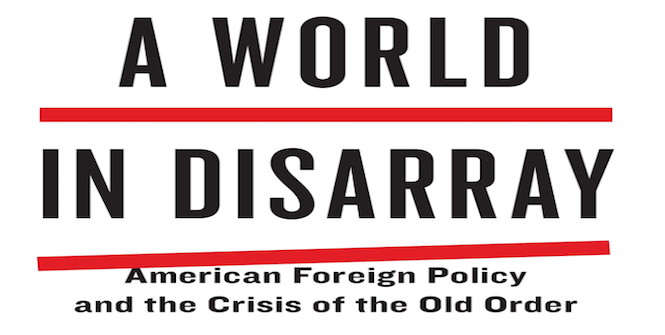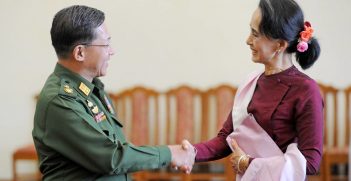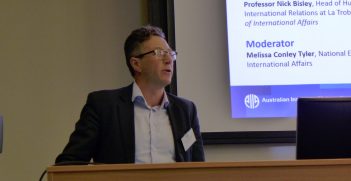Reading Room: A World in Disarray

At the concluding news conference of the annual AUSMIN talks between American and Australian senior ministers, familiar words rolled off the tongue of US Secretary of State Rex Tillerson: the almost century-long relationship between Australia and the United States had been built on the most fundamental of values, including a commitment to a “rules-based world order”.
Such motherhood statements are part of the ritual and are doubtless well meant. Yet they don’t exactly square with the White House announcement by his commander-in-chief, just three days earlier, that the US was going to walk away from a solemn agreement it had signed in Paris less than two years ago, an agreement that was ratified by Congress. Nor does it square with Trump’s failure to commit to NATO a week earlier, a decision that left German Chancellor Angela Merkel casting serious doubts on the Western alliance.
No wonder then that Richard Haass, president of the US Council on Foreign Relations, in his acclaimed book, World in Disarray, argues that the rules-based world order is broken, and needs to be replaced. He calls it World Order 2.0. The core aim is to diminish potential for conflict among the great powers and to encourage cooperation, but there is little evidence of much progress in recent months.
Haass wrote his book before Trump’s inauguration. While anticipating that the former property developer might not improve matters, Haass has not produced a polemic. He has given us a considered review of the geopolitics of the 19th, 20th and early 21st centuries, explaining how a workable world order was built and how we then allowed it to be undermined to the point we are at today.
Haass describes a world emerging from World War II, illustrating it with coloured maps showing each continent’s colonial masters (with North America being the exception). Colonial rule unravelled, the United Nations and the Bretton Woods institutions were created and flourished and a bipolar world emerged. The Cold War had its tragedies but the strategic balance between the two global nuclear powers, the US and the Soviet Union, led to stability and economic growth. The collapse of the Soviet Union heralded a new era for most of us.
Haass had hopes for a new golden age but as we know, it all went badly wrong. The United States discovered that unilateralism has its limits: it may be the most powerful country in the world but, for all this power, it cannot impose a world order. There are too many other powerful actors with ideas of their own and sufficiently strong to dominate in the regions or countries they control.
Unlike many Americans, Haass does not rail against Russian, Chinese or Middle Eastern despots, or even North Korea, for the breakdown of world order. The United States, he says, must take its share of the blame. He deplores attempts to extend NATO to Russia’s borders and to expand its role.
Haass discusses in some detail the United Nations’s mantra, Responsibility to Protect (R2P), first enshrined in a 2005 United Nations World Summit. It proclaimed that “each individual state has the responsibility to protect its populations from genocide, war crimes, ethnic cleansing and crimes against humanity.” An associated motion said the international community also had the responsibility to protect populations from these same threats, including the use of military force, whether the country or government involved asked for it or not.
This was a bold idea. The fact that it has not turned out as intended has much to do with a world in disarray.
First the United Nations, while having the authority to intervene, has often been reluctant to exercise it, not least because of the veto powers of members of the Security Council.
A second factor is the cost of implementing the policy in terms of lives, economic impact and cash. Nowhere is this more evident than in the complex crisis in Syria. All the elements for R2P are there but only a handful of nations, including Australia, are bearing the financial burden of intervention (often with mixed motives) amidst a humanitarian disaster that is beyond control.
Third, it goes wrong where nations choose to trample on another country’s sovereignty through, for example, regime change, instead of focusing on intervening in crimes against humanity or protecting groups against violent persecution. Thus, Haass supports the first Iraq war where US President George H Bush—for whom he was the Middle East advisor—sent troops to the Persian Gulf to liberate Kuwait from Saddam Hussein’s invasion, but not the US-led second Iraq war. This, we recall, was justified on the grounds of weapons of mass destruction, a charge never proven. Saddam was hunted down, captured and publicly hanged. More recently, there have been interventions in Syria, by the British in Libya and by Russia in Ukraine.
Another important aspect of Haass’s thesis is that sovereignty cannot be upheld in an age defined by threats of global terrorism, the spread of nuclear weapons, climate change and cyberspace. Haass names the Paris climate change accord as an example, not anticipating that Donald Trump would abruptly pull his country out.
It would be nice to report that Haass has a solution to the mess that now extends far beyond the Middle East. The trend, he writes, is ‘one of declining order’ that is difficult to manage. He does not end on a hopeful note but refers to the dysfunctional nature of politics, especially in his own country where the burden of rising debt and a deficit out of control will limit America’s ability to act, even if it had the will to do so.
Considering the thoughtful historical analysis that led to the world falling into disarray, some readers may feel let down by its lack of creative solutions. But then, that is the world today.
Richard Haass, A World in Disarray: American Foreign Policy and the Crisis of the Old Order, Council on Foreign Relations, 2017
Colin Chapman is a writer, broadcaster and public speaker, who specialises in geopolitics, international economics, and global media issues. He is immediate past president of AIIA NSW.





